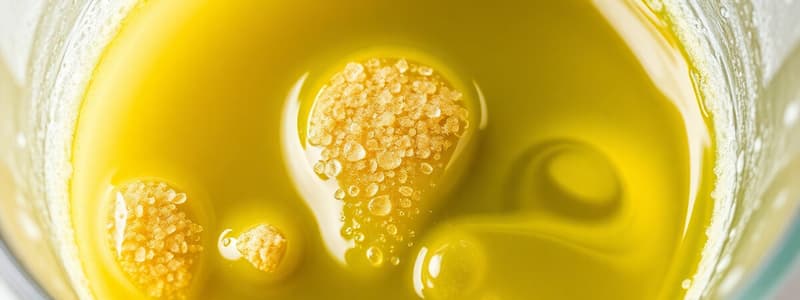Podcast
Questions and Answers
What is the name given to a mixture where the constituents are evenly spread throughout?
What is the name given to a mixture where the constituents are evenly spread throughout?
Homogeneous mixture
What type of mixture is a mixture of chalk and water?
What type of mixture is a mixture of chalk and water?
Heterogeneous mixture
What are the two properties of a mixture?
What are the two properties of a mixture?
The constituents of a mixture may be in any ratio. They retain their individual properties.
The constituents of a mixture do not change when mixed together.
The constituents of a mixture do not change when mixed together.
Give two examples of separation methods that can be used to separate the constituents of a mixture.
Give two examples of separation methods that can be used to separate the constituents of a mixture.
It is necessary to remove undesirable constituents from rice before cooking it.
It is necessary to remove undesirable constituents from rice before cooking it.
Tea leaves are separated from tea by using a strainer.
Tea leaves are separated from tea by using a strainer.
Why is it necessary to separate harmful substances from river water?
Why is it necessary to separate harmful substances from river water?
Air contains many substances, such as gases, smoke and dust particles.
Air contains many substances, such as gases, smoke and dust particles.
What is the organ in our body that requires oxygen for respiration and separates it from other components?
What is the organ in our body that requires oxygen for respiration and separates it from other components?
The process of separating unwanted components is already done by the body, so we don't have to do it.
The process of separating unwanted components is already done by the body, so we don't have to do it.
How is butter obtained?
How is butter obtained?
Crude oil or petroleum is a mixture of several useful constituents
Crude oil or petroleum is a mixture of several useful constituents
How are petrol, kerosene, diesel, tar, etc. obtained?
How are petrol, kerosene, diesel, tar, etc. obtained?
Flashcards
Mixture
Mixture
A substance made up of two or more components mixed together but not chemically combined.
Homogeneous Mixture
Homogeneous Mixture
Has the same properties throughout, like salt dissolved in water.
Heterogeneous Mixture
Heterogeneous Mixture
Has different properties in different parts, like sand and water.
Ratio of Constituents
Ratio of Constituents
Signup and view all the flashcards
Retention of Individual Properties
Retention of Individual Properties
Signup and view all the flashcards
Separation of Constituents
Separation of Constituents
Signup and view all the flashcards
Removal of Undesirable Constituents
Removal of Undesirable Constituents
Signup and view all the flashcards
Food Preparation
Food Preparation
Signup and view all the flashcards
Medical Applications
Medical Applications
Signup and view all the flashcards
Obtaining Useful Constituents
Obtaining Useful Constituents
Signup and view all the flashcards
Decantation
Decantation
Signup and view all the flashcards
Evaporation
Evaporation
Signup and view all the flashcards
Sieving
Sieving
Signup and view all the flashcards
Dissolving and Filtration
Dissolving and Filtration
Signup and view all the flashcards
Magnetic Separation
Magnetic Separation
Signup and view all the flashcards
Centrifugation
Centrifugation
Signup and view all the flashcards
Chromatography
Chromatography
Signup and view all the flashcards
Distillation
Distillation
Signup and view all the flashcards
Sublimation
Sublimation
Signup and view all the flashcards
Sedimentation
Sedimentation
Signup and view all the flashcards
Study Notes
Mixtures
- Mixtures are combinations of two or more substances in any ratio.
- Constituents in a mixture retain their individual properties.
- Mixture constituents do not change when mixed together.
- Mixtures can be separated using various methods.
Homogeneous Mixtures
- Constituents are evenly spread throughout the mixture.
- All parts of a homogeneous mixture have the same properties.
- Examples include sugar in water, air.
Heterogeneous Mixtures
- Constituents are not evenly spread.
- Different parts of the mixture have different properties.
- Examples include iron filings and sand, chalk in water, and dusty air.
Separation of Mixtures
- Separation is needed to remove unwanted components or extract useful ones.
- Examples:
- Removing undesirable constituents from food (e.g., stones from rice, leaves from tea)
- Removing harmful substances from water (e.g., using water filters).
- Obtaining useful constituents (e.g., butter from milk, petroleum products from crude oil).
Identifying Mixtures/Compounds
- Comparing boiling points or melting points can reveal whether a substance is a pure compound or a mixture.
- Pure substances have fixed melting and boiling points.
- Mixtures of substances have variable melting and boiling points depending on their composition.
Studying That Suits You
Use AI to generate personalized quizzes and flashcards to suit your learning preferences.




